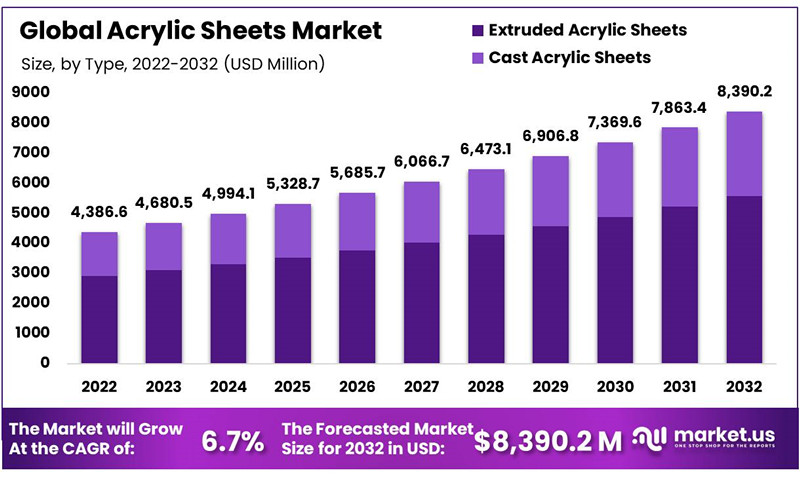September 20, 2023 - New York (GLOBE NEWSWIRE) — According to Market.us reports, the global acrylic sheets market reached a valuation of $4,386.6 million in 2022 and is projected to exceed $8,390.2 million by 2032, with a steady CAGR of 6.7% expected between 2023 and 2032 (Market.us, 2023).

Acrylic sheets, commonly known as acrylic glass or plexiglass, are flexible and transparent plastic sheets made from polymethyl methacrylate (PMMA), a synthetic polymer. Due to their exceptional optical clarity, durability, lightweight nature, and ease of manufacture, these sheets find widespread use across various applications. The global market for acrylic sheets is witnessing growth due to increasing demand for lightweight and durable materials in construction, automotive, and the expanding retail and advertising industries.
Key Insights:
-
The global acrylic sheets market stood at $4,386.6 million in 2022.
-
Cast acrylic sheets dominated the global market with a 66.4% share in 2022, attributed to their superior optical clarity and aesthetic appeal by type.
-
UV-resistant acrylic sheets held a significant market share in 2022 due to their superior UV radiation protection by product type.
-
Construction and architecture led the market in 2022 with a 35.4% market share, owing to exceptional transparency and UV radiation insulation in application. (Market.us, 2023)
Factors Impacting Acrylic Sheets Industry Growth:
-
Construction and Building Industry: Acrylic sheets are extensively used in architectural applications like windows, doors, skylights, and roofing due to their transparency, durability, and lightweight properties, driving growth in construction industries.
-
Technology and Innovation: Changes in manufacturing processes for acrylic sheets, such as improved optical clarity and scratch resistance, can unlock new markets and potentially reduce costs through technological innovation.
-
Environmental Regulations: Concerns and regulations regarding plastics and polymers can affect the acrylic sheet markets, prompting manufacturers to adapt to sustainability requirements using recycled materials or eco-friendly production processes.
-
Raw Material Prices: Fluctuations in oil prices, such as methyl methacrylate (MMA), the primary constituent of acrylic sheets, significantly impact raw material costs and market pricing. (Market.us, 2023)
Industry Trends:
-
Demand for Sustainable Acrylic Sheets: With growing environmental concerns, there's a preference for acrylic sheets manufactured using sustainable processes and materials, aiding manufacturers in developing recyclable acrylic sheets with a lower carbon footprint.
-
Product Development Innovation: Manufacturers continuously strive to enhance acrylic sheet properties, making them more durable, scratch-resistant, and versatile, expanding their applications across various industries. (Market.us, 2023)
Regional Analysis:
APAC led the global acrylic sheets market with a 34.2% share in 2022, driven by construction industries in countries like China and India. Acrylic sheets are widely employed in these nations' construction and interior design sectors. Moreover, the automotive industry's growth also contributed to APAC's market expansion. North America secured the second position, benefiting from a robust industrial and manufacturing sector driving significant demand for acrylic sheets in various applications.


